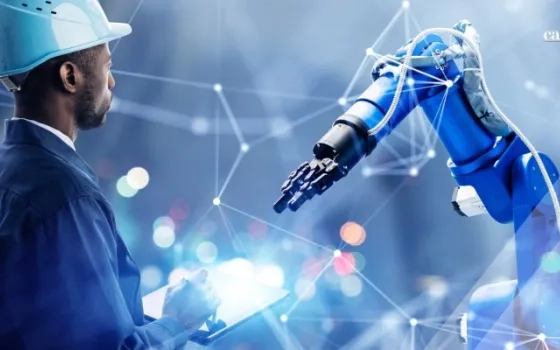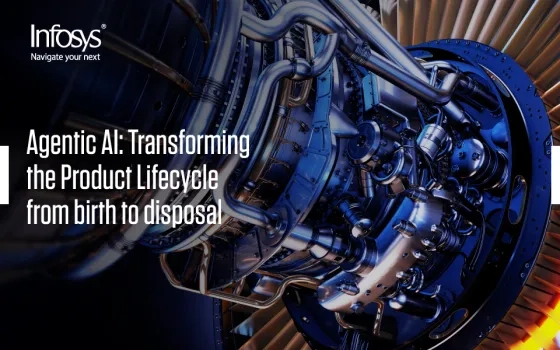Visualize this.
You want a product that doesn’t exist yet. A fairly common request – many entrepreneurs have built large businesses on such a requirement. So, you whip up a design in some software and transfer it to another software that looks at it and simulates every aspect of it perfectly, producing all the data you need to make it and even maintain it properly.
You then walk into a factory, and a computer asks you to send the designs of the product you need to be manufactured to a particular machine. You do so, and the entire factory starts production, with a 3D printer starting to manufacture basic parts.
Multiple sets of machines spin to life, each one producing different components of your design. Computers observe the unceasing production process through sensors, with AI fixing bottlenecks as they appear and improving efficiency with every iteration. As you watch, thousands of pieces are manufactured, assembled, packaged, and shipped, with practically no human intervention.
Sounds like science fiction?
It is – but only for a few more years. Within the next decade or so, science fiction will become a science fact. This is what Industry 4.0 will look like, a world of near-perfect industrial automation.
This is Industry 4.0, the Fourth Industrial Revolution, and we have already started on the path to reaching it. But how did we get here? To find out, let’s look at some history.
First three revolutions
The history of industrial revolutions spans from the year 1784 to the modern-day. The First Industrial Revolution occurred towards the end of the eighteenth century, based on the scientific advancement of water and steam power. The Second Industrial Revolution took place at the beginning of the twentieth century, exemplified by technologies such as conveyor belts and systems of mass production. People like Henry Ford or Frederick Taylor are strongly connected to the Second Industrial Revolution as we see it. The Third Industrial Revolution took place fairly recently and concerned the digital automation of production using electronics and IT systems.
This is where we are right now. But human progress does not stop, and slowly but surely, we are moving towards the Fourth Industrial Revolution.
What makes industry 4.0 special?
There are nine pillars of Industry 4.0. They are:
1) Simulation: Simulations, also known as digital twins, are virtual simulations of real-world products, machines, systems, or processes based on IoT sensor data. They can be used to identify malfunctioning parts, predict potential issues, improve uptime, and train maintenance workers on how to repair them.
2) Internet of Things: Also known as the Industrial Internet of things (IIoT), the IoT system will be the eyes of the company, collecting data from every single sensor in every single production device.
3) The Cloud: The underlying connective tissue of Industry 4.0, cloud computing is the base layer on which everything else is built. By facilitating quick and comprehensive data transfers as well as edge computing, the Cloud is where all the coordination happens.
4) Cybersecurity: Since Industry 4.0 relies so heavily on data transfers, the odds of data breaches go up. As a result, protecting these systems from cyber threats is vital.
5) System Integration: By integrating horizontal and vertical systems, fully automated value chains will be built. This will enable universal data-integration networks, building a unified and resilient system.
6) Big Data and Analytics: In the context of industry 4.0, big data and analytics refer to the comprehensive evaluation and collection of data from all possible sources like production equipment and telemetry systems.
7) Additive Manufacturing: The best-known form of additive manufacturing is 3D printing, and it will likely be used to make small batches of products, customized as per the customer’s order.
8) Augmented Reality: Currently in a nascent stage, these technologies will soon be ubiquitous. With applications ranging from streaming repair instructions to glasses, to selecting parts based on requirements, AR tech holds the potential to increase human efficiency significantly.
9) Autonomous Robotics: By interacting with each other and becoming flexible, cooperative, and capable of problem-solving, autonomous robots will be able to handle ever more complex tasks.
At the height of Industry 4.0, each of these nine pillars will combine into an autonomous whole, making mass production easier than ever before.
How does industrial automation work?
In an industrial setting, automation requires a control system like a computer and large quantities of data to manage the equipment and processes in factories. Since factories and other manufacturing environments need to maintain high levels of output and try to increase efficiency, automation can assist by making bottlenecks easier to spot and maintaining quality.
Automation is mostly used on production lines, which take the form of multiple workstations and a system that moves the raw material through multiple production phases. Each of these workstations uses tools to craft the raw material into the final product. Companies use logic controllers to oversee this process.
These automation infrastructures are used for everything from manufacturing, refining, production of individual parts, and even assembly.
There are four kinds of automated manufacturing systems.
- Flexible Manufacturing Systems (FMS): These systems are designed to be modular and thus extendable, allowing the production lines to handle multiple kinds of products with minimal lag in changeover or production time.
- Programmable: Programmable automation systems are designed to use numerical control machine tools and computer programs to produce variations on a particular product. For example, children’s toys can be manufactured on such a system with variants like different colors being programmed in.
- Rigid: Rigid systems are production systems designed for one highly specific purpose and cannot be changed without overhauling them completely. Due to their specialization, they have the highest production rate among all the other systems.
- Computer Integrated Manufacturing (CIM): Designed for industry 4.0, computer integrated Manufacturing systems control every single part of a factory that uses computer systems for automation or production. This smart and integrated system usually includes pieces of tech like automated cranes, numerical control machine tools, computer-aided planning systems, computer-aided scheduling and production systems, machine systems, robotics, and often feature CAD and CAM integration.
Advantages and challenges of industrial automation
Industrial automation has six main benefits. Let’s see what they are.
- Cost efficiency: Industrial automation processes massively reduce labor costs, while also automating production processes that are either too dangerous for humans to handle or ones that do not require human judgment to perform effectively.
- Scalability and flexibility: When a production process needs to be updated, the people involved often require training. The same is not true for robots, which are infinitely reconfigurable and can be quickly reprogrammed at scale and in a small timeframe.
- Competitive advantages: Automated factories can be easily standardized and procedures can be automatically redesigned as per the latest guidelines and requirements. This allows factories to operate constantly and accurately, while also reducing downtime and increasing productivity.
- Time reduction: Since the factory systems will be integrated with the data systems, the information processing time will drop to almost nothing, allowing things to move much more efficiently.
- Increased safety: Hazardous tasks will be completely taken over by machines, while data security will also be implemented to make sure that all portions of a production process are safe from internal or external attacks.
- Efficiency and control: The working of the networked systems and production processes will be monitored and recorded. This data will then be analyzed to identify patterns, improve processes and implement important changes.
The power of industrial automation is incalculable. It will be able to produce things made-to-order, with a level of customization and flexibility never seen before. Only time will tell how it will change the world.
But if you want to get started on the path to full industrial automation, we’ve got a solution! Calsoft has over 23 years of experience at the cutting edge of technology, and our teams of skilled engineers are trained to work in environments unlike any other. Click here to get in touch!

















